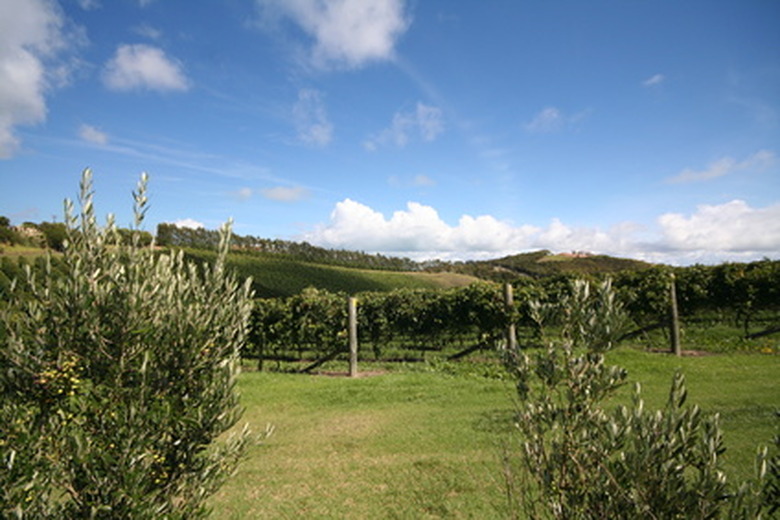Olive Tree Disease
Olive trees are native to the Mediterranean, tropical and central Asia and parts of Africa. There are several things required to successfully grow an olive tree: a long, hot growing season, a frost-free environment and a winter chill to set the fruit. The coastal valleys of California provide this type of environment. Olive trees are evergreens that, when mature, will reach a height of 50 feet and a width of 30 feet. The olive tree is susceptible to verticillium wilt, olive knot, diplodia canker, leaf spot and fruit mummification.
Verticillium Wilt
The fungus verticillium dahliae is responsible for verticillium wilt. The fungus survives in the soil and in the roots of an infected tree. The disease can be spread when the soil is tilled, by water irrigation and by pruning tools that have not been disinfected after pruning a diseased plant. When an olive tree has verticillium wilt, the leaves on one or several branches will wilt and stick to the branch. This wilting will take place during the growing season and will progress to other branches. Verticillium wilt can kill a tree. There is no known method of control. The only way to manage verticillium wilt is to avoid planting an olive tree in an infected site.
- Olive trees are native to the Mediterranean, tropical and central Asia and parts of Africa.
- When an olive tree has verticillium wilt, the leaves on one or several branches will wilt and stick to the branch.
Olive Knot
Olive knot is a bacterial disease caused by pseudomonas syringae pv savastanoi. It is generally found on primary and secondary branches. Signs of olive knot are galls/knots that are ½ inch to 2 inches in diameter. The bacteria enter through a wound or opening in the tree. Olive knot interrupts the water and sugar supply to the tree; when this happens it causes defoliation and dead branches. The bacteria are present in the olive knots, and this bacterial disease spreads by watering and rain. The treatment is preventative. Bactericides that contain copper are applied to wounds–this will minimize the disease. The bactericides should be applied in the fall and spring, but never before harvest. Pruning should be done in the months of July through August (the dry season).
- Olive knot is a bacterial disease caused by pseudomonas syringae pv savastanoi.
- The bacteria are present in the olive knots, and this bacterial disease spreads by watering and rain.
Diplodia Canker
Diplodiae fungus is what causes diplodia canker. The tree, however, is not directly affected by this fungus. The fungus is known to exacerbate olive knot disease. Diplodiae fungus enters the galls formed from olive knot and then enters the tree and forms a canker. These cankers kill small shoots as well as branches. There is no way to control diplodia canker.
Leaf Spot
Leaf spot is also known as peacock spot, olive leaf spot and bird's eye spot. This disease is caused by spilocaea oleaginea, a fungus. Dark green to black round spots appear on the leaves. A yellow halo may sometimes appear around the spot. The results of leaf spot are defoliation and, depending upon the severity of the disease, bloom failure as well as a reduced crop of olives. Trees should be treated with a protective fungicide such as Bordeaux mixture. The fungicide can be applied in early autumn or early spring. Cultivars that are extremely susceptible to leaf spot include Manzanilla, Frantoio, Arbequina and Moroccan Picholine.
- Diplodiae fungus is what causes diplodia canker.
- The results of leaf spot are defoliation and, depending upon the severity of the disease, bloom failure as well as a reduced crop of olives.
Fruit Mummification
Gleosporium olivarum is the fungus that causes fruit mummification. The fungus penetrates the skin of the olive, brownish round spots develop and get larger as the disease progresses. Fruit mummification is found largely in Portugal, Greece and Lebanon. Management of the disease is through applying a preventive fungicide in early September, prior to the rainy season.
